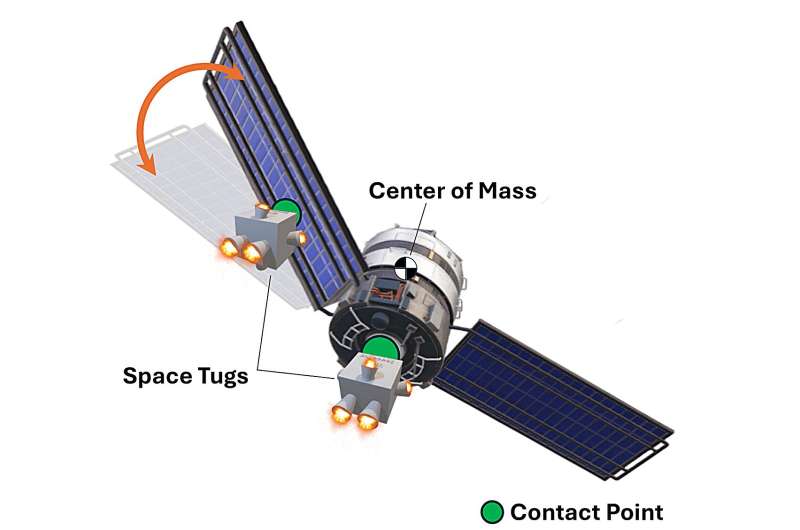August 7, 2024 feature
This article has been reviewed according to Science X's editorial process and policies. Editors have highlighted the following attributes while ensuring the content's credibility:
fact-checked
preprint
trusted source
proofread
An adaptive method to detumble non-rigid satellites using robots

More than 8,000 man-made satellites orbit planet Earth today, many of which were launched into space decades ago. Repairing and maintaining the proper operation of these satellites is not always easy and often requires carefully planned and targeted interventions.
A common satellite maintenance operation is known as "detumbling." This process entails stabilizing and manipulating the orientation of satellites that start to uncontrollably spin (i.e., tumble) in space.
Researchers at the University of New Mexico (UNM) recently introduced a new adaptive method to detumble non-rigid satellites with unknown motion dynamics. Their proposed approach was outlined in a paper posted on the arXiv preprint server and is set to be presented at the IEEE Conference on Decision and Control (CDC 2024) held December 16–19 in Milan, Italy.
"Our paper is based on our current space research funding—SURI," Longsen Gao, first author of the paper, now a third-year Ph.D. student in AgMan Lab as one of the core researchers in this project, told Tech Xplore.
"At UNM, we aim to leverage our multi-robot systems (i.e., space tugs, space servicing multi-arm robotic systems, etc.), which incorporate novel controller designs, to complete complicated servicing and repairing manipulation tasks aimed at fixing malfunctioning space systems, such as satellites, solar panels, rigid or non-rigid parts of space systems, etc."

The key objective of the recent study by Gao and his colleagues was to devise an effective method to detumble non-rigid satellites. Such a method could have important ramifications, as tumbling is a key cause of satellite malfunction, and most existing detumbling solutions are only applicable to rigid satellites.
"There is no other previous research that considers the detumbling problem for non-rigid satellites," Gao said. "Almost all detumbling efforts consider satellites as rigid bodies, simplifying their structure and ignoring potential issues that could arise due to variations in their stiffness.
"Our research reaches beyond this, tackling the non-rigid satellite detumbling problem using two space tugs, one holding the base of the satellite and another holding the malfunctioning solar panel, to transfer the whole satellite module into a two-link chain as a non-rigid system, ceasing the unknown motion of the satellite."
The detumbling method introduced by this team of researchers is adaptive, in the sense that it can be applied to various non-rigid objects irrespective of their properties. In other words, the approach does not require prior knowledge of a satellite (e.g., its mass, inertia, center of mass, shape, stiffness, etc.) to successfully detumble it.
"Most importantly, our method ensures that the multi-agent system can detumble the non-rigid satellite without knowing its grasping position relative to the center of mass of the satellite, which is also a breakthrough compared with SOTA adaptive control methods," Gao explained.
The approach introduced by the researchers entails the use of two robotic systems that attach to the satellite in different locations. These systems apply the force and torque necessary to stabilize the satellite, ceasing its motion and thus returning it to its proper functioning.
"Our adaptive detumbling method deals with the most challenging problem in SOTA detumbling research, namely that most existing approaches ignore the non-rigid structure of the satellite during the detumbling process," Gao said. "We consider this a serious and common issue that may happen on satellites when they are working in space."
The new detumbling approach introduced by Gao and his colleagues could soon be improved and tested further in real experiments, especially in zero-gravity environments. Notably, while the method was designed with the detumbling of non-rigid satellites in mind, it could also be applied to other objects with non-rigid body structures, thus it could potentially be used to tackle other maintenance and repair jobs.
"In our next studies focusing on space servicing and repairs, we will continue exploring how to leverage robotics systems to implement dexterous manipulation work during repairing and servicing tasks," Gao added.
"We plan to combine learning-based methods (e.g., neural networks, machine learning and deep learning) with our control system design to boost the performance on our control algorithm. We are also focusing on robust adaptive MPC algorithms designs that could be applied to space servicing and repairing tasks, which could improve the effectiveness and robustness of our method."
More information: Longsen Gao et al, Adaptive Robot Detumbling of a Non-Rigid Satellite, arXiv (2024). DOI: 10.48550/arxiv.2407.17617
© 2024 Science X Network




















